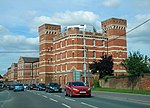Bishops Cannings
Aviation accidents and incidents locations in EnglandCivil parishes in WiltshireEngvarB from June 2016OpenDomesdayVillages in Wiltshire

Bishops Cannings is a village and civil parish in the Vale of Pewsey in Wiltshire, England, 3 miles (5 km) north-east of Devizes. The parish includes the village of Coate (not to be confused with Coate, Swindon) and the hamlets of Bourton, Horton and Little Horton.
Excerpt from the Wikipedia article Bishops Cannings (License: CC BY-SA 3.0, Authors, Images).Bishops Cannings
Church Walk,
Geographical coordinates (GPS) Address Website Nearby Places Show on map
Geographical coordinates (GPS)
| Latitude | Longitude |
|---|---|
| N 51.377 ° | E -1.947 ° |
Address
St. Mary the Virgin
Church Walk
SN10 2JZ , Bishops Cannings
England, United Kingdom
Open on Google Maps









